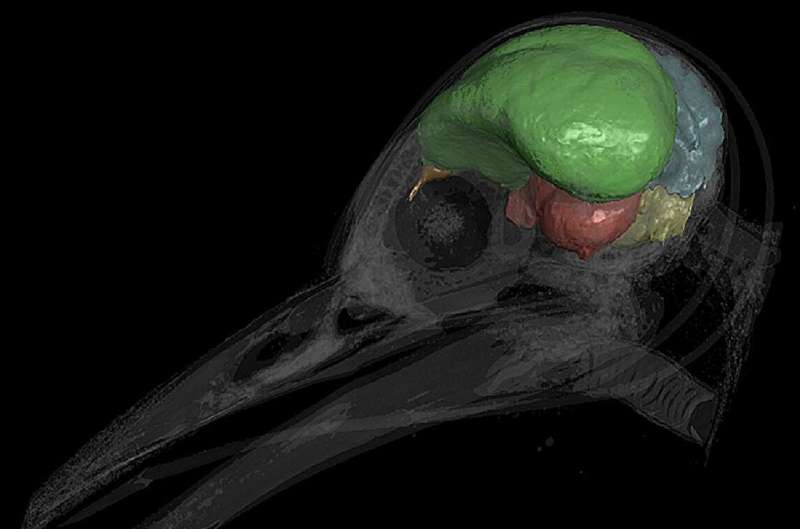This article has been reviewed according to Science X's editorial process and policies. Editors have highlighted the following attributes while ensuring the content's credibility:
fact-checked
peer-reviewed publication
trusted source
proofread
Scientists pinpoint growth of brain's cerebellum as key to evolution of bird flight

Evolutionary biologists at Johns Hopkins Medicine report they have combined PET scans of modern pigeons along with studies of dinosaur fossils to help answer an enduring question in biology: How did the brains of birds evolve to enable them to fly?
The answer, they say, appears to be an adaptive increase in the size of the cerebellum in some fossil vertebrates. The cerebellum is a brain region responsible for movement and motor control.
The research findings are published in the Jan. 31 issue of the Proceedings of the Royal Society B.
Scientists have long thought that the cerebellum should be important in bird flight, but they lacked direct evidence. To pinpoint its value, the new research combined modern PET scan imaging data of ordinary pigeons with the fossil record, examining brain regions of birds during flight and braincases of ancient dinosaurs.
"Powered flight among vertebrates is a rare event in evolutionary history," says Amy Balanoff, Ph.D., assistant professor of functional anatomy and evolution at the Johns Hopkins University School of Medicine and first author on the published research.
In fact, Balanoff says, just three groups of vertebrates, or animals with a backbone, evolved to fly: extinct pterosaurs (the terrors of the sky during the Mesozoic period, which ended over 65 million years ago), bats and birds.
The three species are not closely related on the evolutionary tree, and the key factors or factor that enabled flight in all three have remained unclear.
Besides the outward physical adaptations for flight, such as long upper limbs, certain kinds of feathers, a streamlined body and other features, Balanoff and her colleagues designed research to find features that created a flight-ready brain.
To do so, she worked with biomedical engineers at Stony Brook University in New York to compare the brain activity of modern pigeons before and after flight.
The researchers performed positron emission tomography, or PET, imaging scans, the same technology commonly used on humans, to compare activity in 26 regions of the brain when the bird was at rest and immediately after it flew for 10 minutes from one perch to another. They scanned eight birds on different days.
PET scans use a compound similar to glucose that can be tracked to where it's most absorbed by brain cells, indicating increased use of energy and thus activity. The tracker degrades and gets excreted from the body within a day or two.
Of the 26 regions, one area—the cerebellum—had statistically significant increases in activity levels between resting and flying in all eight birds. Overall, the level of activity increase in the cerebellum differed by more than two standard statistical deviations, compared with other areas of the brain.
The researchers also detected increased brain activity in the so-called optic flow pathways, a network of brain cells that connect the retina in the eye to the cerebellum. These pathways process movement across the visual field.
Balanoff says their findings of activity increase in the cerebellum and optic flow pathways weren't necessarily surprising, since the areas have been hypothesized to play a role in flight. What was new in their research was linking the cerebellum findings of flight-enabled brains in modern birds to the fossil record that showed how the brains of birdlike dinosaurs began to develop brain conditions for powered flight.
To do so, Balanoff used a digitized database of endocasts, or molds of the internal space of dinosaur skulls, which when filled, resemble the brain. She identified and traced a sizable increase in cerebellum volume to some of the earliest species of maniraptoran dinosaurs, which preceded the first appearances of powered flight among ancient bird relatives, including Archaeopteryx, a winged dinosaur.
Balanoff and her team also found evidence in the endocasts of an increase in tissue folding in the cerebellum of early maniraptorans, an indication of increasing brain complexity.
The researchers cautioned that these are early findings, and brain activity changes during powered flight could also occur during other behaviors, such as gliding. They also note that their tests involved straightforward flying, without obstacles and with an easy flight path, and that other brain regions may be more active during complex flight maneuvers.
The research team plans next to pinpoint precise areas in the cerebellum that enable a flight-ready brain and the neural connections between these structures.
Scientific theories for why the brain gets bigger throughout evolutionary history include the need to traverse new and different landscapes, setting the stage for flight and other locomotive styles, says Gabriel Bever, Ph.D., associate professor of functional anatomy and evolution at the Johns Hopkins University School of Medicine.
"At Johns Hopkins, the biomedical community has a wide-ranging set of tools and technology to help us understand evolutionary history and link our findings to fundamental research on how the brain works," he adds.
More information: Quantitative functional imaging of the pigeon brain: implications for the evolution of avian powered flight, Proceedings of the Royal Society B: Biological Sciences (2024). DOI: 10.1098/rspb.2023.2172. royalsocietypublishing.org/doi … .1098/rspb.2023.2172
Journal information: Proceedings of the Royal Society B
Provided by Johns Hopkins University School of Medicine




















